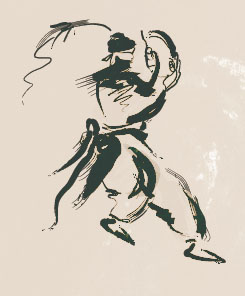
Eolssigu is the only central club performing pungmul at the University of Seoul and has performed for 22 years. The Eolbang is located on the 3rd floor of the Student Hall. I saw a picture of a drummer hanging from the ceiling in front of the club room door. When I entered Eolbang, the traditional musical instruments first caught my eyes. They were arranged evenly on one side of the wall. Some club members were chatting at the table, and I started to interview Eolssigu Daebbang.
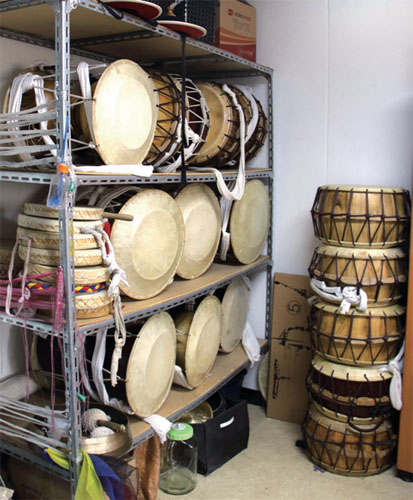
A lot of people confuse pungmul with samulnori. Samulnori derives from pungmul by extracting the fast rhythm of pungmul and combining more contemporary improvisation and composition. The biggest difference between them is that samulnori is performed sitting on the floor, while players of pungmul move around dancing and drumming. Eolssigu practices pungmul and performs on various stages.
Q I heard that Eolssigu had the 22nd annual pungmul concert recently. Could you tell us about the concert?
On Nov. 9, we had a concert at the Main Auditorium of UOS with the title of “See Real.” It has two meanings: one is, literally, “to see reality” and the other is “cereal.” We wanted to show our true selves through our performance. Our intention was to make the audience enjoy our music comfortably like a bowl of cereal in the morning, even though they might not know anything about pungmul. We prepared a lot of contents to show our true colors; besides pungmul?the main performance of the concert?we staged Dance Nanta, a talking time with audience and introduction videos. The preparation was a little bit difficult, but we felt our efforts were rewarded when we heard the audience cheer and clap.
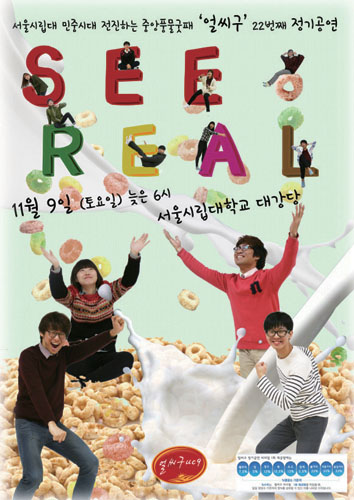
Anyone can join our club, even if he or she has not learned an instrument before. All of our members practice every Wednesday. Sangsoe (the leading gong-player) leads the practice from 7 to 9 p.m. A person chooses one instrument among four? kkwaenggwari, janggu, buk and sogo?and practices pan gut (pungmul performance) based on Yeonggwang udo nongak (sort of pungmul developed in Jeolla-do), which you get to learn during musical instructions. We not only practice how to play the instruments, but also how to move and dance.
Q How is the musical instruction conducted?
Every vacation, we go to Yeonggwang, Jeolla-do for a week-long camp to learn pungmul. We learn the way how to play and dance better from professional instructors there. The schedule is a little tough, but when we come back to Seoul, we find that our play has improved remarkably. We perform and teach freshmen based on them.
Q Are there any foreigners in the club?
There has always been at least one foreigner who has an interest in us every year. Currently, an exchange student from Mexico is working with us. During the club promotion season, she came first with an interest and said that she wanted to join, and now she has practiced and performed with us for about a year.
Q Have you ever suffered any difficulties by doing Eolssigu?
Although, there are many people who love and enjoy it, some people hate the loud sound of pungmul. Especially when we practice pungmul outside, some people file a complaint, and we have to quit our practice. For example, during summer vacation, we had to practice outside because our practicing room was under renovation. But when we were practicing outside, the janitors would always come to us and ask us to stop practicing. We could not help it but to stop practicing. Pungmul is not mainstream. However, we try to better the situation by letting people know what pungmul is and how to enjoy it. After interviewing him, I felt Eolssigu’s pride of playing pungmul. They have performed inside or outside the school many times and have tried to spread our tradition. It was a precious time that highlighted our tradition.
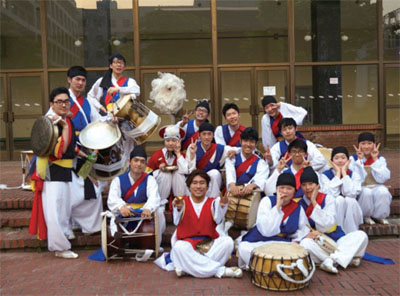
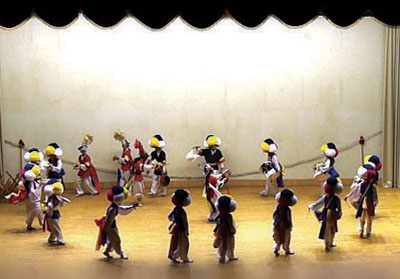

The Annual Events of Eolssigu
Jan-Feb
○ Playing pungmul at Jonggak with other pungmul bands on New Year’s Day.
Mar-April
○ Due to pungmul’s nature of shamanism, Eolssigu visits everywhere on campus and goes into all the club rooms to ward off misfortune and bless them.
○ In the springtime, Eolssigu holds a ceremony to celebrate the anniversary of the club’s foundation with seniors and freshmen. Seniors and freshmen introduce themselves to each other and celebrate the anniversary together.
May-June
○ Eolssigu performs on stage for Daedongje.
○ All members of Eolssigu go to membership training after the first semester.
July-Aug
○ Eolssigu attends to a musical instruction at Yeonggwang to learn pungmul.
Sept-Nov
○ Eolssigu performs at Yinhyangje.
○ An annual pungmul concert, the biggest event in Eolssigu, is held at school, and a lot of guests are invited. They show their passion and effort by staging many performances.
All photos credited by Eolssigu
Lee Ji-min Junior Reporter
kikii32@uos.ac.kr

